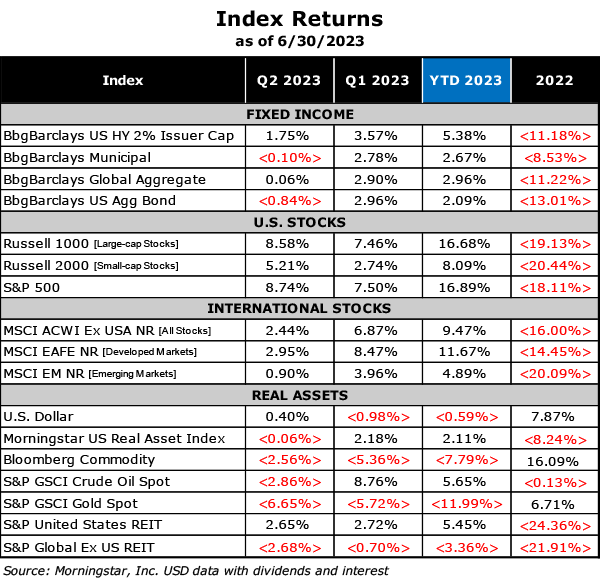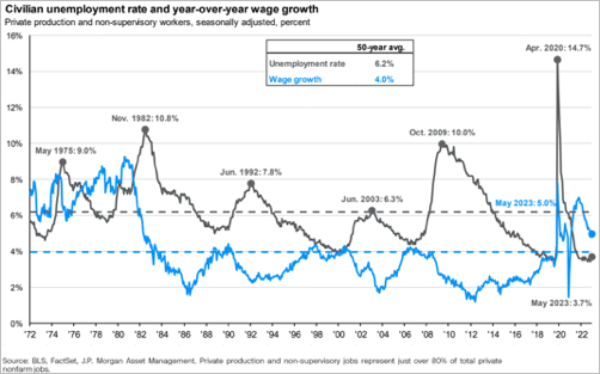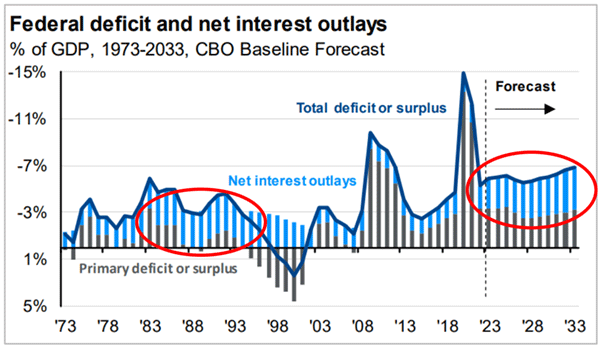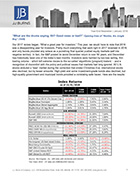“Have mercy, been waiting for the bus all day / I got my brown paper bag / And my take-home pay” ZZ Top, “Waitin’ for the Bus”
In Samuel Beckett’s oft-referenced existential play, “Waiting for Godot,” the central characters hang out waiting for Godot to appear. Much confusion abounds, and (spoiler alert) Godot never appears. Following on this theme of waiting for something that may or may not appear, many economic signs appear to be signaling a recession in the near-term future, and yet markets keep rallying. Further, the Fed has indicated it is comfortable with a slowdown occurring. In the play, secondary characters switch roles being led on a rope—is the Fed leading (causing) or following the recessionary data? Official comments indicate that the central bank is dedicated in its efforts to curb inflation, but as we have noted before, it has not yet had to face recessionary conditions. When it does, will it pivot to spur growth and foster job growth (assuming unemployment rises), or will it continue to focus on inflation? Will a recession actually occur, or will investors be distracted by something else, perhaps the artificial intelligence (AI) phenomenon? It appears, based on the mixed results below, that investors don’t care if ‘Godot’ appears or not. Equity investors have been pleased with earnings results and better valuations after a tough year in 2022. Bonds, notably in the high-yield sector, have rebounded nicely and are not yet displaying elevated default ratios. Higher-quality bonds seem to be reacting to the daily news cycle and comments about the Fed, while commodities and the dollar are reflecting some weakness. U.S. REITs are showing some resilience but concerns about commercial real estate are palpable. Recent results are in the table below:

“I’m trying to make a living / I can’t save a cent / It takes all of my money / Just to eat and pay my rent / I got the blues / Got those inflation blues” B.B. King, “Inflation Blues”
The Fed has indicated that they are focused on reining in inflation, which Chair Powell has said may be a severe headwind to long-term growth if remains too high for too long. ‘Too high’ in this scenario is a level north of 2%, which appears to be a difficult target to achieve in this environment. We also see a serious conflict arising if the economy falls into anything more than a brief, shallow recession – the Fed’s traditional jolt to the economy is to lower interest rates, i.e., lower interest rates. Current consensus is for a brief and shallow recession, but concern surrounds possible Fed actions given their language about staying focused on the inflation fight regardless of the growth environment. This implies a willingness to increase unemployment and severely dampen wage growth, which is finally showing real gains (adjusted for inflation) after years in the doldrums. We can see in the graphs below that the current employment and inflation environments are good in comparison to the late 1980s/early 1990s, for example, when inflation hovered around 4% and unemployment was much higher than current, remaining persistently above 5%. The economy did suffer a brief recession, but continued to grow in the run-up to the Tech Boom. We mention this because it appears the Fed has some room to claim victory if inflation falls to 3% or slightly less. This will allow them to execute a gradual loosening of monetary policy without having to resort to a ‘zero rate’ policy as instituted after the Global Financial Crisis. Also of note is the Fed’s history of dropping rates at least 5% to combat recessions; this would be very difficult in this environment as a cut of this magnitude would bring rates to zero again, and we’re hard-pressed to see that as a desirable policy outcome.
This 50-year history of joblessness demonstrates the difficulty in achieving real-wage growth over the past several decades, as wages did not keep pace with inflation for many years. We can see that the post-pandemic data indicates a shift in the wage dynamic, and this puts pressure on margins. They’re in the Fed’s crosshairs as they look to shrink money supply and tame inflation. Employers will try to contain salaries and raise prices to maintain profits.

We can see the decades of low core-inflation trend investors and consumers have enjoyed beginning in the early 1990s. Note that the 50-year average includes the very high core- and headline-inflation data that caused a strong ramp-up in interest rates in the late ‘70s, which led to a 40-year bull market in bonds. We don’t see the current environment as severe as this past one, but do expect rates to be elevated for some time.

“It’s hard to beat the system / When we’re standing at a distance / So we keep waiting (waiting) / Waiting on the world to change” John Mayer, “Waiting on the World to Change”
Our key concerns aren’t the possibility of recession or the actual level of inflation (the trend is of equal importance given the differing views as to what things should be in the inflation basket). We do believe that some significant but perhaps overlooked economic changes are more important, specifically the level of interest rates and the state of global growth. If rates remain elevated for some time to tamp down inflation, the ripple effects will be more substantial as time passes. Consumer borrowing costs will be higher, debt capital will be more difficult to raise, private capital markets will come under pressure and certain industries that flourish in a low-rate environment (technology) will be more volatile. Global growth (below) is expected to be much lower than the recent non-COVID trend over the next few years, with developed markets performing at very constrained levels. Lingering inflation and high interest rates might promote a long period of stagflation (high inflation and low growth) for some time.

Higher rates are also forecast to have a dampening effect on fiscal policy and will certainly lead to discordant policy fights in the U.S. The so-called ‘crowding out effect,’ in which government borrowing is preferred over public markets, may have some influence over capital markets as well. Republicans are agitating for deep budget cuts and no tax increases, while Democrats are seeking to increase social spending and raise taxes. As the recent debt-ceiling debate demonstrated, both sides are far apart in seeking middle-ground growth and taxation policies.
If this forecast becomes reality, the federal government will be spending higher amounts on interest payments than in the recent past as a percentage of GDP, indeed almost as much as in the 1980s despite some restraint in the actual structural surplus. This is a worrisome trend. It is worth noting that the federal budget is over 70% dedicated to transfer payments, defense and interest on the debt. That leaves little room in the middle for negotiations.

“But I’m not bound / And I never will / Be to a wrinkled, crinkled, wadded dollar bill” Johnny Cash, “Wrinkled, Crinkled, Wadded Dollar Bill”
Thus far in 2023, U.S. and international equities have clearly rebounded from last year’s bear market. The US market surge has been very narrow in breadth thus far, being led by familiar mega-cap technology and consumer names. Emerging markets equities, particularly in dominant China, are not performing as robustly, as China’s easy-money growth, one-child policy and increasing political intransigence and less-than-robust post-COVID reopening are hurting growth. Quality bonds have rebounded, too, but are still seeking a settling rate based on future Fed and economic activity. Yields in many bond sectors are at very attractive levels. We still believe some post-COVID realignment headwinds are over the horizon, as geopolitical concerns (particularly the war in Ukraine) threaten global food and energy supplies. We are using opportunities to harvest losses, trim unwieldy positions as prudent and keep portfolios closely aligned to their ideal allocations.
As always, we urge our clients to focus on their long-term plan and not allow short-term market events to derail them. If there is a short-term goal that needs to be funded, that cash should be set aside in anticipation of withdrawal from the portfolio. If you have invested long enough you know that the market tide will ebb and flow, but diversification allows portfolios to weather the storm. If you have any questions, feel free to contact our office.
As always, we welcome your comments, questions and feedback, and thank you for your trust in us.
– Your Wealth Management Team at JJ Burns & Company
Download Market Commentary
Disclosure: J.J. Burns & Company, LLC is a registered investment adviser with the U.S. Securities & Exchange Commission and maintains notice filings with the States of New York, Florida Pennsylvania, New Jersey, Connecticut, Georgia, Illinois, North Carolina, and California. J.J. Burns & Company, LLC only transacts business in states where it is properly registered, or excluded or exempted from registration. Follow-up and individualized responses to persons that involves either the effecting or attempting to effect transactions in securities, or the rendering of personalized investment advice for compensation, as the case may be, will not be made absent compliance with state investment adviser and investment adviser representative registration requirements, or an applicable exemption or exclusion.
All investing involves risk, including the potential for loss of principal. There is no guarantee that any investment plan or strategy will be successful.
The foregoing content reflects the opinions of J.J. Burns & Company, LLC and is subject to change at any time without notice. Content provided herein is for informational purposes only and should not be used or construed as investment advice or a recommendation regarding the purchase or sale of any security. There is no guarantee that the statements, opinions or forecasts provided herein will prove to be correct.
Past performance may not be indicative of future results. Indices are not available for direct investment. Any investor who attempts to mimic the performance of an index would incur fees and expenses which would reduce returns.
Securities investing involves risk, including the potential for loss of principal. There is no assurance that any investment plan or strategy will be successful.


